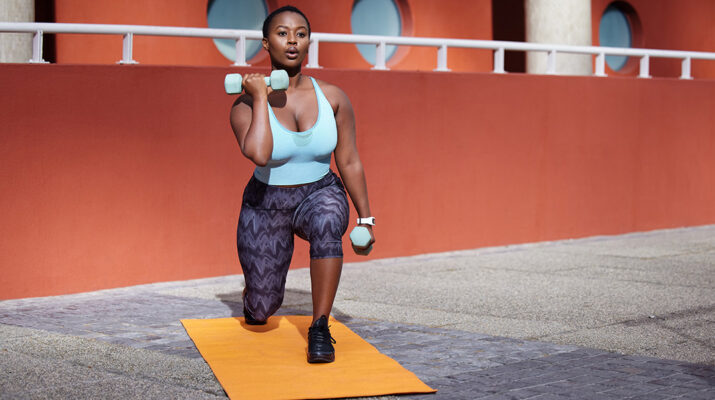Why women should work on getting stronger
By Deborah Jeanne Sergeant
It’s widely reported that women should strength train if they’re trying to lose weight.
Using free weights, a weight machine, body weight exercise or isometric exercise builds muscle and jumpstarts the metabolism.
But women have many more reasons to increase their strength.
Physician Kristen Walker, assistant professor of clinical medicine at Olsan Medical Group, said that not only does regular strength training decrease risk of death for women; it also is more beneficial for women compared with men.
“Specifically, strength training has been shown to lower resting blood pressure, lower low-density lipoprotein, lower triglycerides and increase high-density lipoprotein,” Walker said. “Strength training for at least two days per week has been shown to increase longevity.”
Maintaining strength helps with healthy aging in a variety of ways. In addition to improving a woman’s ability to remain independent, staying strong can also promote “bone health, mobility, metabolic health, mood and cognitive function.
“Strengthening muscles protects joints which consequently reduces stress on joints. Ultimately, strength training leads to reduced joint pain secondary to conditions such as osteoarthritis and fibromyalgia which plaque many women.”
She added that strength training can help control blood glucose, burn visceral fat and reduce hemoglobin A1c and insulin sensitivity. Strength training can also boost mental health with increased self-esteem and independence.
“Increased blood flow with strength training has been connected to a boost in mood which is observed across all stages of life,” Walker said. “Particularly, in older women, recovery of cognitive function has been observed to be associated with strength training.”
Lack of strength can contribute to life-altering falls in older women.
Loss of muscle mass can start as early as age 40 in women and will continue for the rest of their lives unless they actively combat it.
Walker recommends at least two sessions of strength training weekly with eight to 15 repetitions of three to six sets per exercise. This could include:
• Weight machines (split between upper and lower body)
• Free weights (kettles balls, medicine balls, etcetera)
• Resistance bands or tubes
• Body weight: push-ups, squats — add weights, if possible, planks (30 seconds to one minute), wall-sits (30 seconds to one minute), balance (standing one-leg holds, 30 seconds to one minute), weighted vests with walking, walking on an incline and adding resistance to aerobic exercise.
Kimberly Hammond, doctor of physical therapy in outpatient rehabilitation services with UR Thompson Health, said that body weight movement “can be a great place to start, especially if you don’t have a gym membership and are limited with your home gym set-up.
“If you have access to a gym then you would be able to progress to add weights to bodyweight exercise, as well as add in many other challenges. The best exercises and the most bang for your buck are strengthening exercises that target several muscle groups within a given exercise. For example, biceps curls are a great exercise but they are only going to strengthen your biceps. However, if you do a pull up even if it is assisted, you are not only strengthening the biceps but also the latissimus dorsi as well as trapezius, rhomboids, erector spinae and core muscles.”
Check with your local school system or colleges, which may offer free or low-cost access to their fitness facilities.
Staying safe while strength training is vital. Becoming sidelined through injury can affect both short-term gains and long-term function. Walker recommends stretching before and following strength training.
“Muscles are being overloaded by a stress to become stronger,” she said. “These muscles need to be stretched relaxed to avoid injury.”
Using the right technique can also help prevent muscle strain. Ask for help or follow a reputable training video to learn how to do it correctly.
“When strength training, it is important to strengthen larger muscle groups first, followed by smaller muscle groups,” Walker added. “Improper lifting technique leads to recruiting smaller, weaker muscles which are susceptible to injury.”
Hormonal shifts can cause women to become more susceptible to injury, as connective tissues can be laxer during certain times of their cycle. This can put them at “increased risk of ligament injuries such as ACL tears,” Hammond said.
Some women believe that lifting weights will make them appear bulky, so they stick with lighter weights. This won’t result in the gains they would like.
“In order to build and gain muscle you need to lift heavy enough to cause muscle hypertrophy,” Hammond said. “To help pick the right weight, choose a weight and perform the exercise for eight repetitions. If you are struggling to lift it on the last couple repetitions you have chosen the correct weight; if you can barely lift it past two repetitions it is likely too hard and if you are still smiling and not breaking into a sweat on the eighth repetition, consider a heavier weight.”
Do not compromise on proper form to make the right number of repetitions.
A professional can provide guidance on performing the best moves for the desired results. For example, many women want a stronger, tighter core but performing crunches won’t help much.
“It is probably one of the least beneficial core exercises,” Hammond said. “In an article published in Medicine and Science in Sports and Exercise, researchers found that performing a front plank made the abdominals work twice as hard as traditional crunches. In addition, planks strengthen the shoulders, back and glutes which will help with posture while crunches only partly strengthen the core.”
In addition to planks, she recommends exercises like the “dead bug” or pallof press.

